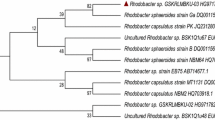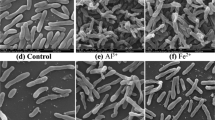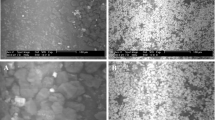Abstract
Biosorption has been shown to be an eco-friendly approach to remove heavy metal ions. In this study, the photosynthetic bacteria Rhodobacter capsulatus was screened and found to have strong ability to adsorb Au(III). The maximum specific uptake of living cells was over 92.43 mg HAuCl4/g dry weight of cell in the logarithmic phase. Biosorpion ability would be enhanced by an acidic environment. As the main cations, during biosorption the quantity of Mg2+ exchanged was more than Na+. Biosorbed Au(III) could be reduced by carotenoid and enzymes embedded and/or excreted by R. capsulatus, which might be the mechanism of photosynthtic bacteria metal tolerance.










Similar content being viewed by others
References
Beveridge TJ, Murray RG (1980) Sites of metal deposition in the cell wall of Bacillus subtilis. J Bacteriol 141:876–887
Crist RH, Oberholser K, Shank N, Nguyen M (1981) Nature of bonding between metallic ions and algal cell walls. Environ Sci Technol 15:1212–1217
Ehrenreich A, Widdel F (1994) Anaerobic oxidation of ferrous iron by purple bacteria, a new type of phototrophic metabolism. Appl Envrion Microbiol 60:4517–4526
Friis N, Myers-Keith P (1986) Biosorption of uranium and lead by Streptomyces longwoodensis. Biotechnol Bioeng 27:21–28
Horikoshi T, Nakajima A, Sakaguchi T (1981) Studies on the accumulation of heavy metal elements in biological systems. Eur J Appl Microbiol Biotechnol 12:90–96
Bang H, Lee EJ, Lee EY, Suh J, Suh MP (2000) Transmetallation of nickel(II) ion in a nickel(II) azamacrocyclic complex with gold(III) ion. Inorg Chim Acta 308:150–154
Kuyucak N, Volesky B (1989) Biosorbents for recovery of metals from industrial solutions. Biotech Lett 33:823–831
Bellion M, Courbot M, Jacob C, Blaudez D, Chalot M (2006) Extracellular and cellular mechanisms sustaining metal tolerance in ectomycorrhizal fungi. FEMS Microbiol Lett 254:173–181
Moore MD, Kaplan S (1992) Identification of intrinsic high-level resistance to rare-earth oxides and oxyanions in members of the class Proteobacteria: characterization of tellurite, selenite, and rhodium sesquioxide reduction in Rhodobacter sphaeroides. J Bacteriol 174:1505–1514
Moore MD, Kaplan S (1994) Members of the family Rhodospirillaceae reduce heavy-metal oxyanions to maintain redox poise during photosynthetic growth. Am Soc Microbiol News 60:17–23
Muraleedharan TR, Iyengar L, Venkobachar C (1991) Biosorption: an attractive alternative for metal removal and recovery. Curr Sci 61:379–385
Nagadomi H, Kitamura T, Watanabe M, Sasaki K (2000) Simultaneous removal of chemical oxygen demand (COD), phosphate, nitrate and hydrogen sulphide in the synthetic sewage wastewater using porous ceramic immobilized photosynthetic bacteria. Biotechnol Lett 22:1369–1374
Gupta R, Ahuja P, Khan S, Saxena RK, Mohapatra H (2000) Microbial biosorbents: meeting challenges of heavy metal pollution in aqueous solutions. Curr Sci 78(8):967–973
Sasaki K, Tanaka T, Nagai S (1998) Use of photosynthetic bacteria for production of SCP and chemicals from organic wastes. In: Martin AM (ed) Bioconversion of waste materials to industrial products, 2nd ed. Blackie Academic and Professionals, New York pp 247–291
He S, Guo Z, Zhang Y, Zhang S, Wang J, Gu N (2007) Biosynthesis of gold nanoparticles using the bacteria Rhodopseudomonas capsulate. Mater Lett 61:3984–3987
Takeno K, Sasaki K, Nishio N (1999) Removal of phosphorus from oyster farm mud sediment using a photosynthetic bacterium, Rhodobacter shaeroides IL106. J Biosci Bioeng 88:410–415
Volesky B (1990) Biosorption of heavy metals. CRC Press, Boca Raton, FL
Widdel F, Schnell S, Heising S, Ehrenreich A, Assmus B, Schink B (1993) Ferrous iron oxidation by anoxygenic phototrophic bacteria. Nature 362:834–836
Ran Y, Fu J, Rate AW, Gilkes RJ (2002) Adsorption of Au (I,III) complexes on Fe, Mn oxides and humic acid. Chem Geol 185:33–49
Acknowledgments
This work is part of the project (40571156) supported by National Natural Science Foundation of China. We are grateful to Professor Gangya Zhang from the Analysis and Testing Center of Institute of Soil Science, Chinese Academy of Sciences for kindly helping with measurements.
Author information
Authors and Affiliations
Corresponding author
Rights and permissions
About this article
Cite this article
Feng, Y., Yu, Y., Wang, Y. et al. Biosorption and Bioreduction of Trivalent Aurum by Photosynthetic Bacteria Rhodobacter capsulatus . Curr Microbiol 55, 402–408 (2007). https://doi.org/10.1007/s00284-007-9007-6
Received:
Accepted:
Published:
Issue Date:
DOI: https://doi.org/10.1007/s00284-007-9007-6




